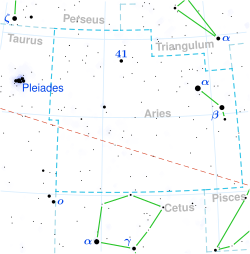Pi Arietis
Multiple star system in the constellation Aries From Wikipedia, the free encyclopedia
Pi Arietis, Latinized from π Arietis, is the Bayer designation for a multiple star system in the northern constellation of Aries. Based upon parallax measurements made during the Hipparcos mission, this system is approximately 800 light-years (250 parsecs) distant from Earth and has an apparent visual magnitude of 5.21. This is bright enough to be faintly seen with the naked eye. The position of this system near the ecliptic means it is subject to lunar occultation.[8]
| Observation data Epoch J2000 Equinox J2000 | |
|---|---|
| Constellation | Aries |
| Right ascension | 02h 49m 17.55924s[1] |
| Declination | +17° 27′ 51.5168″[1] |
| Apparent magnitude (V) | 5.21[2] |
| Characteristics | |
| Spectral type | B6 V + A0 V + F8 V[3] |
| U−B color index | –0.47[2] |
| B−V color index | –0.06[2] |
| Astrometry | |
| Radial velocity (Rv) | +8.8[4] km/s |
| Proper motion (μ) | RA: +2.60[1] mas/yr Dec.: –14.10[1] mas/yr |
| Parallax (π) | 4.18±0.69 mas[1] |
| Distance | approx. 800 ly (approx. 240 pc) |
| Absolute magnitude (MV) | −1.56[5] |
| Details | |
| Luminosity | 538[5] L☉ |
| Rotational velocity (v sin i) | 70[6] km/s |
| Other designations | |
| π Ari, 42 Arietis, BD+16° 355, HD 17543, HIP 13165, HR 836, SAO 93127.[7] | |
| Database references | |
| SIMBAD | data |
The primary member of this system is a massive, B-type main sequence star with a stellar classification of B6 V. It is a close spectroscopic binary with an orbital period of 3.854 days, an eccentricity of 0.04, and a combined visual magnitude of 5.30. At an angular separation of 3.28 arcseconds is a magnitude 8.46 A-type main sequence star with a classification of A0 Vp. Finally, a fourth member of the system is a magnitude 11.0 F-type main sequence star with a classification of F8V at an angular separation of 25.2 arcseconds from the primary.[3]
Name
This star, along with δ Ari, ε Ari, ζ Ari, and ρ3 Ari, were Al Bīrūnī's Al Buṭain (ألبطين), the dual of Al Baṭn, the Belly.[9] According to the catalogue of stars in the Technical Memorandum 33-507 - A Reduced Star Catalog Containing 537 Named Stars, Al Buṭain were the title for five stars : δ Ari as Botein, π Ari as Al Buṭain I, ρ3 Ari as Al Buṭain II, ε Ari as Al Buṭain III dan ζ Ari as Al Buṭain IV.[10]
In Chinese, 左更 (Zuǒ Gēng), meaning Official in Charge of the Forest, refers to an asterism consisting of π Arietis, ν Arietis, μ Arietis, ο Arietis and σ Arietis.[11] Consequently, the Chinese name for π Arietis itself is 左更五 (Zuǒ Gēng wu, English: the Fifth Star of Official in Charge of the Forest.)[12]
References
External links
Wikiwand - on
Seamless Wikipedia browsing. On steroids.

